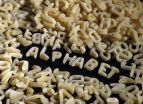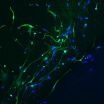(Press-News.org) The headlights – two eyes, the radiator cowling – a smiling mouth: This is how our brain sometimes creates a face out of a car front. The same happens with other objects: in house facades, trees or stones – a "human face" can often be detected as well. Prof. Dr. Gyula Kovács from Friedrich Schiller University Jena (Germany) knows the reason why. "Faces are of tremendous importance for human beings," the neuroscientist explains. That's why in the course of the evolution our visual perception has specialized in the recognition of faces in particular. "This sometimes even goes as far as us recognizing faces when there are none at all."
Until now the researchers assumed that this phenomenon is an exception that can only be applied to faces. But, as Prof. Kovács and his colleague Mareike Grotheer were able to point out in a new study: these distinct adaptation mechanisms are not only restricted to the perception of faces. In the "The Journal of Neuroscience" the Jena researchers have proved that the effect can also occur in the perception of letters. (DOI: 10.1523/JNEUROSCI.5326-13.2014).
The basis for this is the neuronal plasticity of the brain, which allows us to adapt to environmental stimuli. "The more often we are exposed to a certain stimulus, the quicker we perceive it," Mareike Grotheer, doctoral candidate in Kovác's team says. This "training effect" could be measured directly in the brain. As magnetic resonance imaging shows, environmental stimuli which the brain has already adapted to, lead to distinctly lower responses in the processing areas. "This might sound paradoxical at first, but it only means that the brain arrives at the same result with less effort," Kovács points out.
This adaptation mechanism is particularly pronounced in situations when we expect a very specific stimulus. "Our past experiences are essential in shaping our sense of perception," Kovács stresses. For the recognition of characters experience also plays a decisive role. Practically we are surrounded by characters everywhere: in the media, in the streets, on everyday objects.
In their study the researchers showed different characters to test persons and recorded via functional magnetic resonance imaging the brain activity which was set into motion by the process of seeing. "The recordings clearly show that the brain activity adapts to the visual perception of characters in the course of the measurements," Kovács says. However, this only applies to correct roman characters. The Jena researches were not able to detect a similar adaptation in a parallel test series with false, altered characters.
It stands to reason, Prof. Kovács sums up, that the reading and writing experience of a test person is responsible for this adaptation. It is not yet clear, if the adaptability of the brain can be specifically trained to the recognition of characters or if it is the result of evolutionary development processes – which is the case with the recognition of faces: This has to be shown in future research.
INFORMATION:
Original Publication:
Grotheer M, Kovács G. Repetition probability effects depend on prior experiences. The Journal of Neuroscience 2014 (DOI: 10.1523/JNEUROSCI.5326-13.2014)
Contact:
Prof. Dr. Gyula Kovács
Institute of Psychology
Friedrich Schiller University Jena
Leutragraben 1, 07743 Jena
Germany
Phone: ++49 3641 / 945936
Email: gyula.kovacs@uni-jena.de
Seeing is a matter of experience
Neuroscientists of Jena University, Germany, discover adaptation mechanisms of the brain when perceiving letters of the alphabet
2014-05-21
ELSE PRESS RELEASES FROM THIS DATE:
Cyberbullying affects rich and poor alike
2014-05-21
EAST LANSING, Mich. --- Cyberbullying isn't just a problem in middle class and affluent areas. Teenagers in poor, high-crime neighborhoods also experience online bullying, finds new research led by a Michigan State University criminologist.
The study suggests the "digital divide" – the gap between people with access to online technologies and those without – may be nonexistent, at least when it comes to cyberbullying, said Thomas J. Holt, MSU associate professor of criminal justice.
"We found neighborhood conditions that are indicative of poverty and crime are a significant ...
NASA sees developing tropical cyclone in Bay of Bengal
2014-05-21
VIDEO:
In this TRMM 3-D simulated flyby of System 92B from May 19, tall storms were shown reaching heights of over 14km (about 8.7 miles).
Click here for more information.
A tropical low pressure area known as System 92B has been organizing in the Northern Indian Ocean's Bay of Bengal and NASA's TRMM satellite has shown strong thunderstorms and heavy rainfall in the developing storm.
The Tropical Rainfall Measuring Mission or TRMM satellite passed over System 92B on May 19 and ...
Shared custody is becoming the norm
2014-05-21
It's no longer a certainty that American mothers will get custody over their children during a divorce. In fact, if Wisconsin Court Records of the past 20 years are anything to go by, joint custody is becoming the norm. So says Maria Cancian and colleagues from the University of Wisconsin–Madison in the US, whose findings are published in Springer's journal Demography.
For most of the twentieth century, in both divorce and nonmarital cases, most children ended up living with their mothers after their parents' divorce. This conformed to gender norms that views mothers ...
Functional nerve cells from skin cells
2014-05-21
A new method of generating mature nerve cells from skin cells could greatly enhance understanding of neurodegenerative diseases, and could accelerate the development of new drugs and stem cell-based regenerative medicine.
The nerve cells generated by this new method show the same functional characteristics as the mature cells found in the body, making them much better models for the study of age-related diseases such as Parkinson's and Alzheimer's, and for the testing of new drugs.
Eventually, the technique could also be used to generate mature nerve cells for transplantation ...
Low IQ students learn to read at 1st-grade level after persistent, intensive instruction
2014-05-21
VIDEO:
Children identified as intellectually disabled or with low IQ learned to read at a first-grade level after persistent, intensive instruction from a scientifically based curriculum. The findings of the pioneering...
Click here for more information.
The findings of a pioneering four-year educational study offer hope for thousands of children identified with intellectual disability or low IQ who have very little, if any, reading ability.
The study by researchers at Southern ...
On the road to improvement: EPA's troubled program on chemical hazards
2014-05-21
Out of the thousands of chemicals used for countless everyday products, about 500 have been assessed for potential health risks by the federal program tasked with this colossal duty. The good news is the Environmental Protection Agency, which runs the program, has improved it, but more remains to be done, according to a report from the National Research Council (NRC). Chemical & Engineering News (C&EN), the weekly news magazine of the American Chemical Society, hits the report's highlights.
Cheryl Hogue, senior correspondent for C&EN, explains that the EPA program, called ...
A new solution for storing hydrogen fuel for alternative energy
2014-05-21
Turning the "hydrogen economy" concept into a reality, even on a small scale, has been a bumpy road, but scientists are developing a novel way to store hydrogen to smooth out the long-awaited transition away from fossil fuels. Their report on a new solid, stable material that can pack in a large amount of hydrogen that can be used as a fuel appears in the ACS journal Chemistry of Materials.
Umit B. Demirci and colleagues explain that storing hydrogen in solids is a recent development and a promising step toward building a hydrogen economy. That's the idea originated ...
Paper-based diagnostics, made with a scrapbooking tool, could curb hepatitis C pandemic
2014-05-21
To the relief of patients diagnosed with hepatitis C, the U.S. Food and Drug Administration approved two new treatments late last year, and a few more are on the way. Now scientists are solving another side of the disease's problem: identifying the millions more who have the virus but don't know it — and unwittingly pass it on. A report in the ACS journal Analytical Chemistry describes a novel, scrapbook-inspired test that does just that.
Xuan Mu, Zhi Zheng and colleagues point out that the hepatitis C virus (HCV), a blood-borne pathogen that can cause liver cirrhosis, ...
Not just for the heart, red wine shows promise as cavity fighter
2014-05-21
For anyone searching for another reason to enjoy a glass of red wine with dinner, here's a good one: A new study has found that red wine, as well as grape seed extract, could potentially help prevent cavities. They say that their report, which appears in ACS' Journal of Agricultural and Food Chemistry, could lead to the development of natural products that ward off dental diseases with fewer side effects.
M. Victoria Moreno-Arribas and colleagues explain that dental diseases are extremely common throughout the world. Cavities, periodontal disease and tooth loss affect ...
University of Maryland School of Medicine research finds drugs that may treat MERS virus
2014-05-21
A team led by a University of Maryland School of Medicine (UM SOM) researcher, working as a grantee from the National Institutes of Health (NIH), has identified a number of existing drugs that could be "repurposed" to fight outbreaks of Middle East respiratory syndrome coronavirus (MERS-CoV) and severe acute respiratory syndrome coronavirus (SARS-CoV).
Clinicians treating patients suffering from MERS currently have no drugs specifically targeted to the MERS-CoV, a virus first detected in humans in 2012 that has since caused 572 laboratory-confirmed infections, including ...
LAST 30 PRESS RELEASES:
Making lighter work of calculating fluid and heat flow
Normalizing blood sugar can halve heart attack risk
Lowering blood sugar cuts heart attack risk in people with prediabetes
Study links genetic variants to risk of blinding eye disease in premature infants
Non-opioid ‘pain sponge’ therapy halts cartilage degeneration and relieves chronic pain
AI can pick up cultural values by mimicking how kids learn
China’s ecological redlines offer fast track to 30 x 30 global conservation goal
Invisible indoor threats: emerging household contaminants and their growing risks to human health
Adding antibody treatment to chemo boosts outcomes for children with rare cancer
Germline pathogenic variants among women without a history of breast cancer
Tanning beds triple melanoma risk, potentially causing broad DNA damage
Unique bond identified as key to viral infection speed
Indoor tanning makes youthful skin much older on a genetic level
Mouse model sheds new light on the causes and potential solutions to human GI problems linked to muscular dystrophy
The Journal of Nuclear Medicine ahead-of-print tip sheet: December 12, 2025
Smarter tools for peering into the microscopic world
Applications open for funding to conduct research in the Kinsey Institute archives
Global measure underestimates the severity of food insecurity
Child survivors of critical illness are missing out on timely follow up care
Risk-based vs annual breast cancer screening / the WISDOM randomized clinical trial
University of Toronto launches Electric Vehicle Innovation Ontario to accelerate advanced EV technologies and build Canada’s innovation advantage
Early relapse predicts poor outcomes in aggressive blood cancer
American College of Lifestyle Medicine applauds two CMS models aligned with lifestyle medicine practice and reimbursement
Clinical trial finds cannabis use not a barrier to quitting nicotine vaping
Supplemental nutrition assistance program policies and food insecurity
Switching immune cells to “night mode” could limit damage after a heart attack, study suggests
URI-based Global RIghts Project report spotlights continued troubling trends in worldwide inhumane treatment
Neutrophils are less aggressive at night, explaining why nighttime heart attacks cause less damage than daytime events
Menopausal hormone therapy may not pose breast cancer risk for women with BRCA mutations
Mobile health tool may improve quality of life for adolescent and young adult breast cancer survivors
[Press-News.org] Seeing is a matter of experienceNeuroscientists of Jena University, Germany, discover adaptation mechanisms of the brain when perceiving letters of the alphabet





